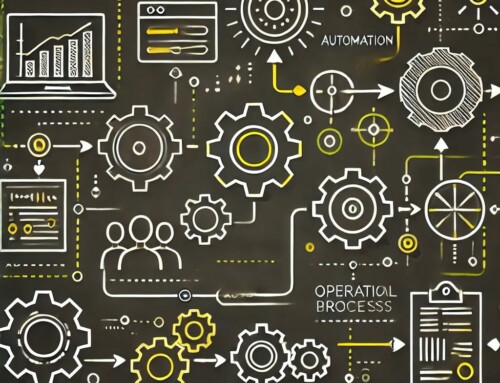
Architecting Utility Excellence Through Value Stream Mastery. From Grid to Customer: Unlocking Operational Value in Every Flow.
The utilities sector stands at a pivotal crossroads. As pressure mounts from regulatory demands, sustainability imperatives, grid modernization needs, and evolving customer expectations, utilities must find new ways to optimize operations while maintaining reliability and affordability. Traditional approaches built around functional silos and technical domains are no longer sufficient to meet these complex challenges.
Business architecture value streams provide a powerful framework for understanding and optimizing how utilities deliver value. Unlike process maps that focus on how work gets done, value streams illuminate what value is delivered, to whom, and through which capabilities—creating a holistic view that transcends organizational boundaries. This customer-centric perspective enables utilities to identify and eliminate friction points, streamline handoffs, and align capabilities to maximize value delivery.
1: The Value Stream Imperative for Utilities
Value streams provide a revolutionary lens for understanding how utilities create and deliver value to customers and stakeholders. This perspective is increasingly critical in today’s transforming utility landscape.
- Customer-Centricity: Value streams shift focus from internal operations to how the utility delivers value to customers and stakeholders, aligning the organization with evolving expectations.
- Cross-Functional Clarity: Traditional utility silos between grid operations, customer service, and other functions create costly inefficiencies that value streams make visible and actionable.
- Operational Friction: Value streams reveal critical handoff points and bottlenecks where time, information, and accountability are often lost between departments.
- Strategic Alignment: Value stream mapping ensures operational improvements directly support strategic objectives rather than localized optimization that may not improve overall outcomes.
- Technology Enablement: Value streams create the context for technology investments by showing how digital capabilities support end-to-end value delivery rather than departmental functions.
2: Business Architecture Value Streams vs. Traditional Process Maps
Business architecture value streams differ fundamentally from traditional process documentation, providing a more strategic perspective on value creation and delivery.
- Value Focus vs. Activity Focus: Value streams highlight what value is delivered and to whom, while process maps detail the specific activities and tasks required to deliver that value.
- Strategic vs. Tactical: Value streams operate at a more strategic level, showing the major stages in value delivery, while process maps capture tactical execution details.
- External vs. Internal: Value streams begin and end with external stakeholders, maintaining focus on value recipients, while process maps often reflect internal organizational boundaries.
- Capability-Centered vs. Role-Centered: Value streams connect to the business capabilities required at each stage, while process maps typically focus on roles, responsibilities and handoffs.
- Stable vs. Variable: Value streams remain relatively stable over time as they reflect fundamental value propositions, while processes frequently change as utilities optimize how work gets done.
3: Core Utility Value Streams: Customer Lifecycle Management
Customer lifecycle value streams encompass the entire journey from initial connection to ongoing service management and eventual disconnection. These value streams directly impact customer satisfaction and revenue generation.
- Service Enrollment: This value stream captures the end-to-end flow from initial customer contact through service activation, including application processing, credit verification, and connection establishment.
- Billing and Payment: This critical value stream spans from meter reading/data collection through bill calculation, delivery, payment processing, and exception handling.
- Service Request Management: This value stream encompasses the fulfillment of customer requests from initial contact through completion and confirmation across all channels.
- Complaint Resolution: This high-impact value stream covers the complete handling of customer complaints from receipt through investigation, resolution, and prevention measures.
- Move In/Move Out Management: This value stream manages customer transitions between service locations, including setup, final billing, and service transfers.
Did You Know:
- A 2023 study of utility operational performance found that companies using value stream-based improvement approaches achieved 42% greater cycle time reduction and 37% higher first-pass quality improvements compared to traditional process improvement initiatives.
4: Core Utility Value Streams: Asset Lifecycle Management
Asset lifecycle value streams focus on how utilities plan, deploy, operate, maintain, and retire the physical infrastructure that delivers energy services. These value streams directly impact reliability, safety, and capital efficiency.
- Asset Planning & Investment: This value stream encompasses needs identification through investment approval, design, and construction readiness for new or replacement infrastructure.
- Asset Construction & Commissioning: This value stream covers the end-to-end flow from construction initiation through testing, commissioning, and handover to operations.
- Asset Maintenance: This critical value stream spans inspection planning, execution, deficiency identification, work order management, and maintenance performance evaluation.
- Asset Performance Management: This value stream encompasses monitoring, analysis, optimization, and reporting on asset performance against reliability, efficiency, and financial targets.
- Asset Retirement: This value stream manages the end-of-life process for assets, including decision-making, decommissioning, salvage/disposal, and financial reconciliation.
5: Core Utility Value Streams: Grid Operations
Grid operations value streams focus on the core energy delivery functions that maintain safe, reliable service while optimizing grid performance. These value streams directly impact service quality, operational costs, and customer satisfaction.
- Outage Management: This high-visibility value stream spans from outage detection through assessment, dispatching, restoration, and analysis to prevent future occurrences.
- Network Operations: This real-time value stream encompasses monitoring, controlling, and optimizing the distribution or transmission network to maintain service quality and system stability.
- Demand Response Management: This increasingly important value stream covers customer enrollment, event forecasting, notification, execution, settlement, and performance analysis.
- Distributed Resource Integration: This emerging value stream manages the interconnection, operation, and optimization of customer-owned generation and storage resources with the utility grid.
- Vegetation Management: This critical reliability value stream spans inspection, prioritization, scheduling, execution, and verification of vegetation work to prevent outages and fire risks.
6: Value Stream Mapping Methodology for Utilities
A structured approach to value stream mapping ensures utilities capture both strategic context and operational detail necessary for meaningful improvement.
- Value Stream Identification: Begin by identifying and prioritizing major value streams based on strategic importance, customer impact, and improvement opportunity.
- Value Stream Definition: For each priority value stream, define the trigger events, end states, stages, stakeholders, and value metrics that establish clear boundaries and success measures.
- Capability Mapping: Identify the business capabilities required at each stage of the value stream, providing the connection between what value is delivered and what capabilities enable that delivery.
- Information Flow Analysis: Document the critical information required and produced at each stage, identifying opportunities to eliminate redundant data collection and close information gaps.
- Value Stream Visualization: Create clear visualizations that communicate the end-to-end flow, highlighting stages, handoffs, capabilities, systems, and metrics in an intuitive format.
7: Assessing Value Stream Performance
Value stream assessment transforms static maps into dynamic tools for operational improvement by identifying performance gaps and optimization opportunities.
- Value Metrics: Establish specific measures for the overall value stream that reflect stakeholder-perceived value, such as time-to-value, quality, cost, and customer satisfaction.
- Stage Effectiveness: Evaluate the performance of each value stream stage using measures such as cycle time, defect rates, rework levels, and capability maturity.
- Handoff Efficiency: Assess the quality and timeliness of transitions between stages, often the greatest source of delays and errors in utility operations.
- Capability Alignment: Evaluate how well existing capabilities support value stream requirements, identifying capability gaps that constrain overall performance.
- Technology Enablement: Assess how effectively technology supports the value stream, identifying automation opportunities, integration gaps, and system constraints.
8: Value Stream Optimization Strategies
Once value streams are mapped and assessed, utilities can apply targeted strategies to eliminate waste, reduce friction, and enhance value delivery.
- Value Stream Simplification: Eliminate unnecessary stages, approvals, and handoffs that don’t contribute to stakeholder value but add time and complexity.
- Handoff Optimization: Improve transitions between stages by clarifying expectations, standardizing information exchange, and implementing clear accountability.
- Capability Enhancement: Strengthen capabilities that directly impact value stream performance through process improvement, training, or technology enablement.
- Parallel Processing: Identify opportunities to perform non-dependent activities concurrently rather than sequentially to reduce overall cycle time.
- Exception Handling: Develop streamlined paths for managing exceptions and special cases that currently disrupt value stream flow and create delays.
9: Technology Enablement Through Value Streams
Value streams provide essential context for technology investment decisions, ensuring solutions support end-to-end value delivery rather than point process improvements.
- Technology Mapping: Document the systems and applications that support each value stream stage, revealing gaps, redundancies, and integration needs.
- Digital Opportunity Assessment: Identify high-impact opportunities for automation, integration, and digital enhancement based on value stream friction points.
- Architecture Alignment: Ensure enterprise and solution architecture decisions support efficient value stream execution across organizational boundaries.
- Integration Prioritization: Use value stream maps to prioritize system integration efforts based on their impact on end-to-end performance.
- Technology Roadmapping: Develop technology roadmaps that sequence investments based on value stream priorities and dependencies.
Did You Know:
- According to a 2024 utility customer experience benchmark study, utilities that have mapped and optimized their customer-facing value streams report 38% higher customer satisfaction scores and 26% lower cost-to-serve compared to utilities that manage customer operations through traditional functional silos.
10: Organizational Optimization Through Value Streams
Value stream perspectives often reveal opportunities to realign organizational structures, governance, and metrics to better support end-to-end value delivery.
- Organizational Alignment: Consider restructuring teams and departments to reduce handoffs and align more closely with end-to-end value streams rather than functional specialties.
- Governance Redesign: Establish governance mechanisms that promote value stream optimization rather than functional excellence at the expense of overall performance.
- Metrics Realignment: Shift performance metrics from functional activity measures to value stream outcome measures that encourage cross-functional collaboration.
- Role Evolution: Create new roles such as value stream owners who maintain end-to-end accountability across traditional organizational boundaries.
- Skill Development: Identify and develop cross-functional skills that enable staff to manage broader segments of value streams with fewer handoffs.
11: Customer Experience Transformation Through Value Streams
Customer-facing value streams provide powerful insights for enhancing utility customer experience across touchpoints and channels.
- Journey-Stream Alignment: Map customer journeys to value streams to identify where internal operations directly impact customer experience moments that matter.
- Channel Optimization: Assess how value streams perform across different channels, ensuring consistent capabilities and information regardless of how customers engage.
- Moment Analysis: Identify critical moments within value streams where customer perception is disproportionately shaped, focusing improvement efforts on these high-impact points.
- Digital Enhancement: Use value stream analysis to prioritize digital investments that remove friction from customer interactions and enable self-service capabilities.
- Experience Measurement: Implement targeted experience metrics at key value stream stages to provide early warning of customer satisfaction issues.
12: Grid Modernization Through Value Stream Optimization
Grid modernization initiatives benefit significantly from value stream perspectives that connect technology investments to operational outcomes and customer value.
- Investment Prioritization: Use value stream performance gaps to prioritize grid modernization investments that deliver the greatest operational and customer impact.
- Use Case Development: Create detailed use cases for grid technologies based on how they will enhance specific value streams rather than technical specifications alone.
- Benefit Realization: Establish clear connections between grid investments and value stream performance improvements to track and validate benefits.
- Operational Readiness: Assess organizational readiness to absorb new grid technologies by evaluating value stream capability maturity and identifying preparation needs.
- Integration Planning: Use value stream maps to identify critical integration requirements between operational technology and information technology domains.
13: Regulatory Management Through Value Streams
Value streams can significantly enhance regulatory management by connecting compliance requirements to operational execution and demonstrating prudent investment decisions.
- Compliance Mapping: Identify which value streams are impacted by specific regulatory requirements, ensuring comprehensive compliance coverage.
- Rate Case Support: Use value stream frameworks to articulate how capital investments and operational improvements deliver customer value, supporting rate case justifications.
- Performance Reporting: Develop more meaningful regulatory performance reporting based on value stream outcomes rather than isolated metrics.
- Prudency Demonstration: Document how systematic value stream optimization guides investment decisions, strengthening prudency arguments in regulatory proceedings.
- Stakeholder Communication: Use value stream frameworks to communicate complex operational concepts to regulators and other stakeholders in business-focused language.
14: Implementing Value Stream Management
Establishing an effective value stream management practice ensures sustained focus on cross-functional optimization and continuous improvement.
- Executive Sponsorship: Secure executive-level commitment to value stream management as a cornerstone of operational strategy and performance improvement.
- Value Stream Ownership: Assign clear accountability for each major value stream to leaders who can work across organizational boundaries to drive optimization.
- Governance Integration: Incorporate value stream perspectives into existing governance forums for strategy, operations, technology, and performance management.
- Capability Development: Build organizational capabilities in value stream mapping, analysis, and optimization through training, tools, and methodologies.
- Continuous Improvement: Establish regular review cycles to reassess value stream performance, refresh value stream maps, and identify new optimization opportunities.
Takeaway
Business architecture value streams provide utilities with a powerful framework for operational optimization that transcends traditional functional silos. By focusing on how value flows from trigger events to stakeholder outcomes, value streams reveal critical opportunities to eliminate waste, reduce handoffs, strengthen capabilities, and enhance technology enablement. This holistic perspective ensures improvement efforts align with strategic priorities and customer needs rather than local optimization that may not improve end-to-end performance. As utilities navigate industry transformation, value stream mastery becomes increasingly essential for balancing reliability, affordability, sustainability, and customer satisfaction in an increasingly complex operating environment.
Next Steps
- Identify Strategic Value Streams: Select 2-3 high-impact value streams that align with current strategic priorities, such as customer experience enhancement or grid modernization.
- Form Cross-Functional Teams: Assemble diverse teams with representation from all functions involved in each selected value stream to ensure comprehensive perspective.
- Map Current State: Document the current state of priority value streams, focusing on stages, handoffs, capabilities, and pain points that impact overall performance.
- Assess Performance: Gather available metrics and qualitative input to assess current value stream performance, identifying the most significant gaps and constraints.
- Prioritize Improvements: Develop a prioritized improvement roadmap that addresses the most critical value stream performance gaps through capability enhancement, handoff optimization, and technology enablement.
- Establish Governance: Implement lightweight governance to maintain value stream focus, track improvement progress, and ensure sustained attention to end-to-end optimization.



